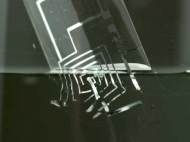Transient electronics dissolve in body or environment
 A research team led by biomedical engineers at Tufts University in collaboration with researchers at the University of Illinois at Urbana-Champaign developed a technology they call transient electronics – small and fully biocompatible electronic devices that are able to dissolve harmlessly into their surroundings after functioning for a desired amount of time, thus eliminating the need for surgical removal.
A research team led by biomedical engineers at Tufts University in collaboration with researchers at the University of Illinois at Urbana-Champaign developed a technology they call transient electronics – small and fully biocompatible electronic devices that are able to dissolve harmlessly into their surroundings after functioning for a desired amount of time, thus eliminating the need for surgical removal.
“These devices are the polar opposite of conventional electronics whose integrated circuits are designed for long-term physical and electronic stability”, said Fiorenzo Omenetto, professor of biomedical engineering at Tufts School of Engineering. “Transient electronics offer robust performance comparable to current devices but they will fully resorb into their environment at a prescribed time — ranging from minutes to years, depending on the application. Imagine the environmental benefits if cell phones, for example, could just dissolve instead of languishing in landfills for years.”
Led by UIUC’s John Rogers, the researchers developed ultrathin flexible electronic components composed out of the materials used in conventional integrated circuits (silicon and magnesium) but in an ultrathin form that is then encapsulated in silk protein. Only a few tens of nanometers thick, these tiny circuits, from transistors to interconnects, readily dissolve in a small amount of water or body fluid. Controlling materials at these scales makes it possible to fine-tune how long it takes the devices to dissolve.
Both silicon and magnesium occur naturally in the environment and have been explored for various medical implants and drug-delivery systems, although in bulk structural forms. The amount of each material in a transient electronic system is much smaller than the recommended daily allowance – the magnesium is even less than that found in a multivitamin – or even less than normal physiological levels. At the same time, it is enough for sophisticated electronics with integrated functions.
Device dissolution is further controlled by sheets of silk protein in which the electronics are supported and encapsulated. Omenetto and his Tufts colleagues have discovered how to adjust the properties of silk so that it degrades at a wide range of intervals such as minutes, hours, days, weeks or potentially, years, all depending on the silk packaging.
Extracted from silkworm cocoons, silk protein is one of the strongest, most robust materials known. It’s also fully biodegradable and its biocompatibility already made it useful in other medical applications.
The researchers managed to demonstrate the usability of their platform by testing a thermal device designed to monitor and prevent post-surgical infection (demonstrated in a rat model) and also created a 64 pixel digital camera.
The researchers envision that their technology could be used in more complex devices that could be adjustable in real time or responsive to changes in their environment, such as chemistry, light or pressure.
Aside promising new breakthroughs in medicine, transient electronics could be used as environmental monitors and consumer electronics that can become compost rather than waste.
For more information, read the paper published in the journal Science: “A Physically Transient Form of Silicon Electronics“.









I see so many uses for this tech. Well done!